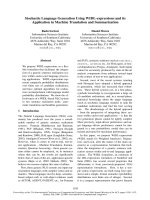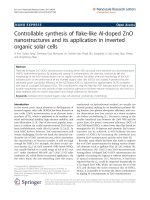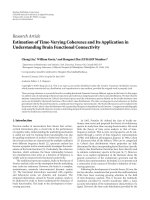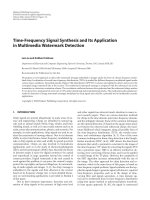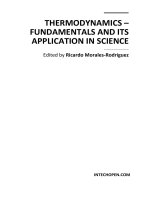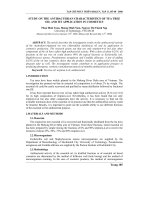Advance Deep Learning Model And Its Application In Semantic Relationship Extraction.pdf
Bạn đang xem bản rút gọn của tài liệu. Xem và tải ngay bản đầy đủ của tài liệu tại đây (613.77 KB, 18 trang )
<span class="text_page_counter">Trang 1</span><div class="page_container" data-page="1">
VIETNAM NATIONAL UNIVERSITY, HANOI UNIVERSITY OF ENGINEERING AND TECHNOLOGY
Can Duy Cat
ADVANCE DEEP LEARNING MODEL AND ITS APPLICATION
IN SEMANTIC RELATIONSHIP EXTRACTION
UNDERGRADUATE THESIS DEFENSE IN REGULAR EDUCATION SYSTEM Major: Computer Science
Instructor: Prof. Ha Quang Thuy
Co-Instructor: Assoc.Prof Chng Eng Siong
HÀ NỘI – 2024
</div><span class="text_page_counter">Trang 2</span><div class="page_container" data-page="2">Relation Extraction (RE) is one of the most fundamental task of Natural Language Processing (NLP) and Information Extraction (IE). To extract the relationship between two entities in a sentence, two common approaches are (1) using their shortest dependency path (SDP) and (2) using an attention model to capture a context-based representation of the sentence. Each approach suffers from its own disadvantage of either missing or redundant information. In this work, we propose a novel model that combines the advantages of these two approaches. This is based on the basic information in the SDP enhanced with information selected by several attention mechanisms with kernel filters, namely RbSP (Richer-but-Smarter SDP). To exploit the representation behind the RbSP structure effectively, we develop a combined Deep Neural Network (DNN) with a Long Short-Term Memory (LSTM) network on word sequences and a Convolutional Neural Network (CNN) on RbSP.
Experimental results on both general data (SemEval-2010 Task 8) and biomedical data (BioCreative V Track 3 CDR) demonstrate the out-performance of our proposed model over all compared models.
Keywords: Relation Extraction, Shortest Dependency Path, Convolutional Neural Network, Long Short-Term Memory, Attention Mechanism.
</div><span class="text_page_counter">Trang 3</span><div class="page_container" data-page="3">I would first like to thank my thesis supervisor Prof. Ha Quang Thuy of the Data Science and Knowledge Technology Laboratory at University of Engineering and Technology. He consistently allowed this paper to be my own work, but steered me in the right the direction whenever he thought I needed it.
I also want to acknowledge my co-supervisor Assoc.Prof Chng Eng Siong from Nanyang Technological University, Singapore for offering me the internship opportunities at NTU, Singapore and leading me working on diverse exciting projects.
Furthermore, I am very grateful to my external advisor MSc. Le Hoang Quynh, for insightful comments both in my work and in this thesis, for her support, and for many motivating discussions.
</div><span class="text_page_counter">Trang 4</span><div class="page_container" data-page="4">I declare that the thesis has been composed by myself and that the work has not be submitted for any other degree or professional qualification. I confirm that the work submitted is my own, except where work which has formed part of jointly-authored publications has been included. My contribution and those of the other authors to this work have been explicitly indicated below. I confirm that appropriate credit has been given within this thesis where reference has been made to the work of others.
I certify that, to the best of my knowledge, my thesis does not infringe upon anyone’s copyright nor violate any proprietary rights and that any ideas, techniques, quotations, or any other material from the work of other people included in my thesis, published or otherwise, are fully acknowledged in accordance with the standard referencing practices. Furthermore, to the extent that I have included copyrighted material, I certify that I have obtained a written permission from the copyright owner(s) to include such material(s) in my thesis and have fully authorship to improve these materials.
Master student Sinh Vien Can Duy Cat
</div><span class="text_page_counter">Trang 5</span><div class="page_container" data-page="5">1.3. Difficulties and Challenges...10
2. Materials and Methods...11
2.1. Theoretical Basis...11
2.1.1. Simple Recurrent Neural Networks...11
2.1.2. Long Short-Term Memory Unit...12
3. Experiments and Results...12
3.1. Implementation and Configurations...12
</div><span class="text_page_counter">Trang 6</span><div class="page_container" data-page="6">Adam Adaptive Moment Estimation ANN Artificial Neural Network
BiLSTM Bidirectional Long Short-Term Memory CBOW Continuous Bag-Of-Words
CDR Chemical Disease Relation CID Chemical-Induced Disease CNN Convolutional Neural Network DNN Deep Neural Network
</div><span class="text_page_counter">Trang 8</span><div class="page_container" data-page="8">List of table
</div><span class="text_page_counter">Trang 9</span><div class="page_container" data-page="9">1. Giới thiệu 1.1. Động lực
With the advent of the Internet, we are stepping into a new era, the era of information and technology where the growth and development of each individual, organization, and society is relied on the main strategic resource - information. There exists a large amount of unstructured digital data that are created and maintained within an enterprise or across the Web, including news articles, blogs, papers, research publications, emails, reports, governmental documents, etc. Lot of important information is hidden within these documents that we need to extract to make them more accessible for further processing.
1.2. Đặt vấn đề
Relation Extraction task includes of detecting and classifying relationship between entities within a set of artifacts, typically from text or XML documents. Figure 1.1 shows an overview of a typical pipeline for RE system. Here we have to sub-tasks: Named Entity Recognition (NER) task and Relation Classification (RC) task.
A Named Entity (NE) is a specific real-world object that is often represented by a word or phrase. It can be abstract or have a physical existence such as a person, a location, a organization, a product, a brand name, etc. For example, “Hanoi” and “Vietnam” are two named entities, and they are specific mentions in the following sentence: “Hanoi city is the capital of Vietnam”. Named entities can simply be viewed as entity instances (e.g., Hanoi is an instance of a city). A named entity mention in a particular sentence can be using the name itself (Hanoi), nominal (capital of Vietnam), or pronominal (it). Named Entity Recognition is the task of seeking to locate and classify named entity mentions in unstructured text into pre-defined categories.
</div><span class="text_page_counter">Trang 10</span><div class="page_container" data-page="10">1.3. Difficulties and Challenges
Relation Extraction is one of the most challenging problem in Natural Language Processing. There exists plenty of difficulties and challenges, from basic issue of natural language to its various specific issues as below:
Lexical ambiguity: Due to multi-definitions of a single word, we need to specify some criteria for system to distinguish the proper meaning at the early phase of analyzing. For instance, in “Time flies like an arrow”, the first three word “time”, “flies” and “like” have different roles and meaning, they can all be the main verb, “time” can also be a noun, and “like” could be considered as a preposition.
Syntactic ambiguity: A popular kind of structural ambiguity is modifier placement. Consider this sentence: “John saw the woman in the park with a telescope”. There are two preposition phases in the example, “in the park” and “with the telescope”. They can modify either “saw” or “woman”. Moreover, they can also modify the first noun “park”. Another difficulty is about negation. Negation is a popular issue in language understanding because it can change the nature of a whole clause or sentence.
</div><span class="text_page_counter">Trang 11</span><div class="page_container" data-page="11">2. Materials and Methods
In this chapter, we will discuss on the materials and methods this thesis is focused on. Firstly, Section 3.1 will provide an overall picture of theoretical basis, including distributed representation, convolutional neural network, long short-term memory, and attention mechanism. Secondly, in Section 3.2, we will introduce the overview of our relation classification system. Section 3.3 is about materials and techniques that I proposed to model input sentences to extract relations. The proposed materials include dependency parse tree (or dependency tree) and dependency tree normalization; shortest dependency path (SDP) and dependency unit. I further present a novel representation of a sentence; namely Richer-but-Smarter Shortest Dependency Path (RbSP); that overcome the disadvantages of traditional SDP and take advantages of other useful information on dependency tree.
2.1. Theoretical Basis
In recent years, deep learning has been extensively studied in natural language processing, a large number of related materials have emerged. In this section, we briefly review some theoretical basis that are used in our model: distributed representation (Subsection 3.1.1), convolutional neural network (Sub-section 3.1.2), long short-term memory (Sub-section 3.1.3), and attention mechanism (Sub-section 3.1.4).
2.1.1. Simple Recurrent Neural Networks
CNN model are capable of capturing local features on the sequence of input words. However, the long-term dependencies play the vital role in many NLP tasks. The most dominant approach to learn the long-term dependencies is Recurrent Neural Network (RNN). The term “recurrent” applies as each token of the sequence is processed in the same manner and every step depends on the previous calculations and results. This feedback loop distinguishes recurrent networks from feed-forward networks, which ingest their own outputs as their input moment after moment. Recurrent networks are often said to have “memory” since the input sequence has information itself and recurrent networks can use it to perform tasks that feed-forward networks cannot.
</div><span class="text_page_counter">Trang 14</span><div class="page_container" data-page="14">Proposed system comprises of three main components: IO-Module (Reader and Writer), Pre-processing module, and Relation Classifier. The Reader receives raw input data in many formats (e.g., SemEval 2010 task 8 [29], BioCreative V CDR [65]) and parse them into an unified document format. These document objects are then passed to Pre-processing phase. In this phase, a document is segmented into sentences, and tokenized into tokens (or words). Sentences that contain at least two entities or nominals are processed by dependency parser to generate a dependency tree and a list of corresponding POS tags. A RbSP generator is followed to extract the Shortest Dependency Path and relevant information. In this work, we use spaCy(1 – footnote: spaCy: An industrial-strength NLP system in Python: ) to segment documents, to tokenize sentences and to generate dependency trees. Subsequently, the SDP is classified by a deep neural network to predict a relation label from the pre-defined label set. The architecture of DNN model will be discussed in the following sections. Finally, output relations are converted to standard format and exported to output file.
3. Experiments and Results
3.1. Implementation and Configurations
3.1.1. Model ImplementationOur model was implemented using Python version 3.5 and TensorFlow . TensorFlow is a free and open-source platform designed by the Google Brain team for data-flow and differentiable programming across a number of machine learning tasks. It has a comprehensive, flexible ecosystem of tools, libraries and community resources that are used to bring out state-of-the-art in many tasks of ML. TensorFlow can be used in research and industrial environment as well.
Other Python package requirements include:
</div>

